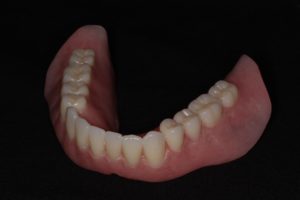Addressing the Implant Overdenture
In an earlier edition of the Byte, I discussed keys to success involving removable dental prostheses. This issue will continue with the topic, but focus on the use of endosseous dental implants to help improve patient outcomes. Let’s look at three common questions regarding the use of dental implants for ovedenture therapy.

How many dental implants are needed for overdentures?
There is no consensus between published studies and experts on this question, and the maxilla and mandible differ significantly when discussing overdenture therapy. The literature is replete with mandibular overdenture studies, yet there are very few addressing the maxilla.1 Here are a few items to take into consideration:
- Patient anatomy – Clearly there are anatomic limitations with each patient that must be considered before discussing implant therapy. A 3D CBCT image is crucial to seeing anatomical limitations before implants are planned or placed. There is not much room for angulation error when removable prostheses are utilized with implants. At least two implants in the anterior mandible are recommended to support an overdenture, but some believe three are better. Four or more and the overdenture becomes more much complicated. Many studies show that two implants in the mandible are adequate, and more implants do not improve the clinical outcome. For the maxilla, two are often utilized for additional retention with a full palate, but at least four should be considered before the palate can be removed from the denture. As the number of implants increases the denture becomes more complicated.

2. Occlusal Factors– Is your patient a delicate denture bird who is accustomed to functioning lightly with dentures? Studies show that edentulous patients cannot generate the same amount of force when chewing as those with implants or teeth.2 Two implants in the mandible for “normal” functioning patients are often sufficient. However, big burly grinders may end up destroying their prostheses and abutments no matter how many implants are placed. It is best to consider every patient a “grinder” until proven otherwise. The patient with heavy parafunctional habits will require more time and recalls than average and you will want to factor this in before treating the patient.
3. Patient goals with removable treatment. Be honest with a patient who is considering having all their dentition removed. Patients rarely function the same with dentures as a substitute. Some patients function better with implants and overdentures, however, patients with xerostomia or arthritis often function worse with removable prostheses, whether implant supported or traditional. Be upfront with your patient if you feel that removable prostheses are not going to meet their expectations. Although fixed implant therapy will sound costly to them at first, their quality of life must be factored into the equation.
Are mini-implants a viable option for dentures?
A recent review by Bidra discussed the lack of medium- and long-term scientific data to support the use of mini-implants (less than 2.0mm in diameter) for fixed and removable therapy.3 Although mini-implants are often used in orthodontics or for very temporary indications, there is insufficient data to support their long-term use for overdenture therapy. There may be indications for narrow diameter implants (2.0-3.0mm in diameter), however no consensus has occurred with these either. If your patient falls into a category with limited bone volume, it may be best to work with a team of specialists to achieve a better outcome with regular-sized implants.
Should implants be splinted with a bar for an overdenture?
This is yet another topic that does not have enough evidence to support one philosophy over another. Any type of treatment with a bar will increase costs and chair time. Individual ball or locator attachments can often times be used successfully when the number of implants is kept within reason. The decision to splint will often occur because of indications such as parafunctional habits, available restorative space and number of implants. It is important to factor in the cost of a bar initially as CAD/CAM bars are superior to cast bars.
I hope this information on implant overdenture therapy has been helpful. Please do not hesitate to contact me if you have patients you would like to discuss or refer. I am always available to you for phone consults and treatment planning.
Dr. Emily Batson is a native of Colorado Springs, CO. She is a graduate of Indiana University School of Dentistry, and served in the United States Army following dental school. She has returned to her hometown after completing her specialty training in Prosthodontics at the University of North Carolina at Chapel Hill and has a private practice limited to Prosthodontics.
- References:
- Roccuzzo M, et al. “ What is the optimal number of implants for removable reconstructions? A systematic review on implant-supported overdentures.” Clin Oral Imp Res 2012; 23: 229-237.
- Jemt T, Stalblad P. “The effect of chewing movement on changing complete mandibular overdentures to osseointegrated overdentures.”J Prosthet Dent 1986; 55:355-361.
- Bidra, A, Khalid A. “Mini implants for definitive prosthodontic treatment: A systematic review.” J Prosthet Dent 2013; 109: 156-164.
